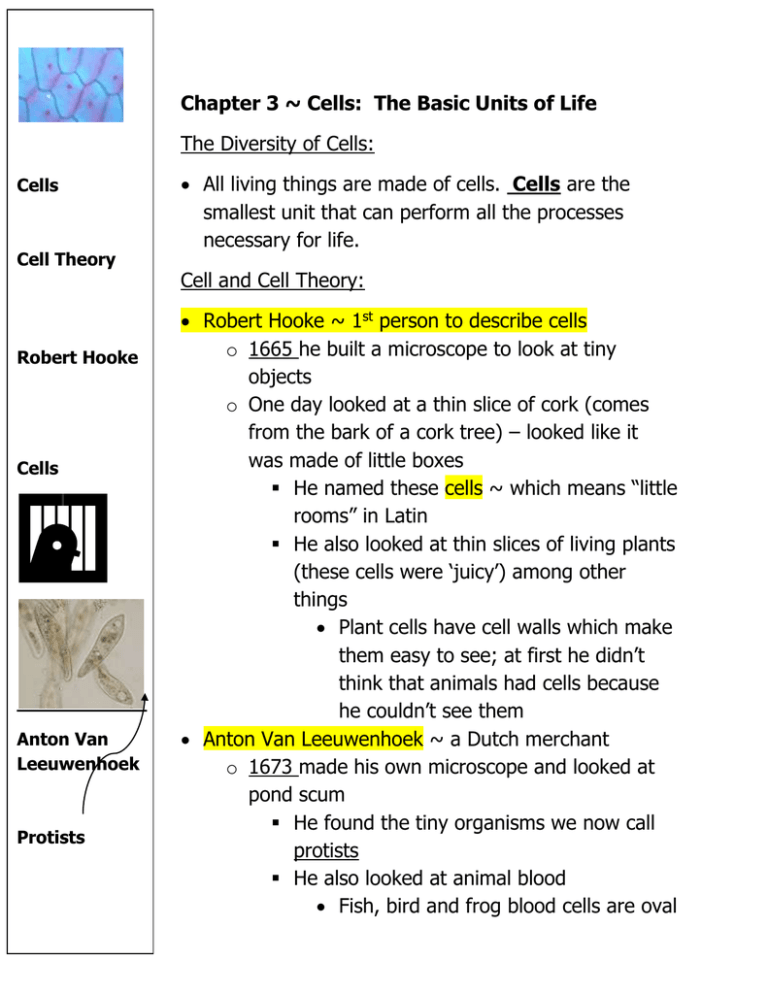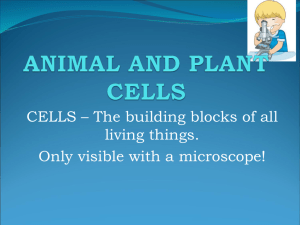Cell Notes
advertisement

Chapter 3 ~ Cells: The Basic Units of Life The Diversity of Cells: Cells Cell Theory Robert Hooke Cells Anton Van Leeuwenhoek Protists All living things are made of cells. Cells are the smallest unit that can perform all the processes necessary for life. Cell and Cell Theory: Robert Hooke ~ 1st person to describe cells o 1665 he built a microscope to look at tiny objects o One day looked at a thin slice of cork (comes from the bark of a cork tree) – looked like it was made of little boxes He named these cells ~ which means “little rooms” in Latin He also looked at thin slices of living plants (these cells were ‘juicy’) among other things Plant cells have cell walls which make them easy to see; at first he didn’t think that animals had cells because he couldn’t see them Anton Van Leeuwenhoek ~ a Dutch merchant o 1673 made his own microscope and looked at pond scum He found the tiny organisms we now call protists He also looked at animal blood Fish, bird and frog blood cells are oval Human and dog blood cells are flat and round He was also the first person to CELL THEORY – all three parts! Mathias Schleiden Theodor Schwann Rudolf Virchow see bacteria! Cell Theory (200 years later…) Mathias Schleiden studied plants 1838 – concluded all plant parts were made of cells Theodor Schwann – studied animals 1839 – concluded all animal parts were made of cells o Wrote the 1st two parts of the Cell Theory 1. All organisms are made of 1 or more cells 2. The cell is the basic unit of all living things Rudolf Virchow – stated the 3rd part of the Cell Theory 1858 – 3rd part of Cell Theory 3. All cells come from existing cells. Cell Size Most cells are too small to be seen with the naked eye. It would take 50+ human cells to cover the dot on this i ~ WOW! There are a few very large cells o The yolk of a chicken egg ~ it can be this big because they do not have to take in more nutrients! But why are cells so small? Small cell size Surface area-tovolume ratio Physically, cells have to take in food and get rid of wastes through the cell membrane o As a cell gets bigger, it needs more food and produces more waste o *** As a cell’s volume goes up, its surface area becomes too small to take in enough nutrients or pump out enough waste Surface area-to-volume ratio surface area Volume Parts of a Cell Cell membrane Cell membrane ~ a phospholipid protective layer that covers the cell’s surface and acts as a barrier Controls material going in and out of a cell Inside the cell is a fluid called cytoplasm Cytoplasm Organelle Nucleus Organelles – small bodies in a cell’s cytoplasm that are specialized to perform specific functions in the cell Genetic material – all cells contain DNA In some cells, the DNA is enclosed in an organelle called the nucleus There are two kinds of cells: Prokaryote Eubacteria Archaebacteria Eukaryote 1. Prokaryotic cells – have no nucleus, singlecelled organism o Two types of prokaryotic cells Eubacteria Common bacteria No nucleus, but do contain DNA Have a cell wall Archaebacteria Single-celled Some live in very unusual places (Yellowstone Park) They are called o Heat-loving extremophiles. o Salt-loving o Methane-making Volcanic vents in the ocean 2. Eukaryotic cells – largest cells (10x’s larger than most bacteria) o Have a nucleus that contains the cell’s DNA o Have many organelles Organelles: Nucleus Nucleolus Ribosome Endoplasmic reticulum Smooth ER Rough ER Mitochondria Chloroplasts Photosynthesis Chlorophyll 1. Nucleus – holds a cell’s DNA – 2 membranes 2. Nucleolus – inside the nucleus; makes ribosomes 3. Ribosome – make proteins; smallest organelle a. Not membrane-bound b. Some float freely in cytoplasm, some are attached to the endoplasmic reticulum 4. Endoplasmic reticulum (ER) (like the highway of the cell) a. tubes and passageways for transporting materials to different places in the cell b. smooth ER – no ribosomes attached c. rough ER – ribosomes attached i. ribosomes make proteins that the ER delivers throughout the cell 5. Mitochondria (the power plant of the cell) a. Main power source of the cell b. Sugar is broken down to produce energy c. Covered by 2 membranes d. In most cells, ATP (energy) is made in the mitochondria 6. Chloroplasts (plants) a. Photosynthesis takes place in chloroplasts i. Uses sunlight and water to make sugar and oxygen b. Green color is from chlorophyll which traps the energy of the sun Golgi complex Cell wall Cell membrane Hydrophobic Hydrophilic 7. Golgi Complex – (like the UPS store) a. Packages and distributes proteins b. The membrane of the Golgi pinches off with materials inside that need to be transported 8. Cell wall (plants, algae and fungi) a. Rigid structure that gives support to a cell b. Made of cellulose and other materials 9. Cell membrane a. Protective barrier that encloses a cell b. Contains proteins, lipids and 2 layers of phospholipids i. Water fearing or hydrophobic ii. Water loving or hydrophilic c. Help control the movement of materials into and out of a cell through specialized passageways To recap: the cell membrane 1. Protects the cell and 2. Helps control the movement of materials into and out of a cell Cytoskeleton Vesicle 10. Cytoskeleton a. Web of proteins in cytoplasm b. Acts as a muscle and a skeleton c. http://www.dnatube.com/video/5968/Cyto skeleton-microtubules-cell-biology 11. Cell compartments a. Vesicle = small sac that surrounds material to be moved into and out of a cell Lysosomes Vacuoles b. Lysosomes = contain digestive enzymes that do the following… i. Get rid of wastes ii. Get rid of old organelles iii. Protect the cell from foreign invaders iv. Mostly found in animal cells c. Vacuoles – a large vesicle i. Generally found in plant and fungal cells ii. Acts like a large lysosome iii. Some store water and other liquids Thank you – We are done!!!!! WooHoo! PLEASE PUT THESE IN A SAFE PLACE (YOUR SCIENCE FOLDER)!









